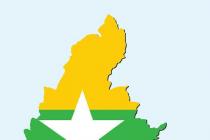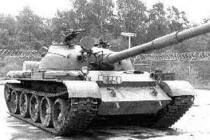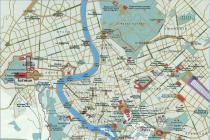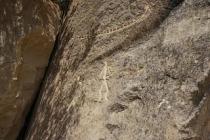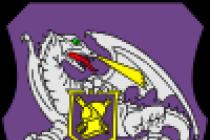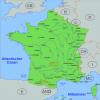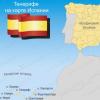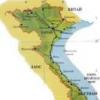Major P. Goncharenko
The Armed Forces (AF) of the Federal Democratic Republic of Ethiopia (FDRE) perform the functions assigned to them in the context of overcoming the consequences of the conflict with the state of Eritrea and the difficult military-political situation in the East African region, being the main guarantor of the country's security. Taking into account the special role of the Armed Forces in the political system of the state, the leadership of the republic is taking all necessary measures to increase their combat potential.
In accordance with the FDRE constitution, Prime Minister M. Zenawi is the Supreme Commander of the Armed Forces and exercises overall leadership through the Ministry of National Defense (MHO). The competence of the Minister of Defense (K. Demeksa - a civilian) includes issues of general personnel policy, material and technical support, procurement of weapons and military equipment and a number of others. Direct command and control of troops is entrusted to the Chief of the General Staff (Lieutenant General S. Ienus).
The Armed Forces of the FDRE have a two-service structure and consist of ground forces (ground forces), air forces and air defense forces (air force and air defense). In a threatened period and in wartime, irregular formations are transferred to the operational subordination of the command of the Armed Forces. In addition, at present, territorial troops are being created (the headquarters was formed in 2003), for the recruitment of which the military personnel dismissed from the ranks of the Armed Forces are sent.
Despite the fact that the Armed Forces of Ethiopia are the most combat-ready and technically equipped in the region, the military leadership still believes that their combat capabilities do not fully meet the requirements of ensuring the country's territorial integrity and internal political stability. With long-term planning of the development of the armed forces, its leadership is forced to rely on foreign military assistance.
In 2004, in accordance with a contract with the FDRE Department of Defense, British military specialists conducted a comprehensive assessment of the combat potential of the Ethiopian armed forces. According to the findings of the study, the country's military command and control system does not ensure the rational use of funds allocated for defense needs.
In order to optimize the costs of the military department, British specialists have developed a plan for reforming the FDRE armed forces for the period until 2010. Its key point is a change in the organizational and staff structure of the Armed Forces, which will reduce the number of their personnel by 15-20%. The released funds are planned to be used to modernize existing weapons and purchase new weapons and equipment, which will increase the mobility and equipment of the army. The restructuring of the military education system will make it possible to raise the level of training of servicemen and save funds allocated for training national military personnel abroad. The state started directly reforming the armed forces in 2005.
The main type of the country's Armed Forces is ground forces. They are assigned the leading role in repelling possible external aggression and ensuring internal political stability. The SV is led by the Chief of the General Staff, who is also the commander of this type of Armed Forces. The number of personnel of the ground forces is 180 thousand people (according to The Military Balance 2005-2006), the trained reserve of ground forces (citizens fit for military service) is up to 350 thousand.
| Table 1 | |
| Name of weapons and military equipment | Qty |
| Battle tanks: | 300 |
| T-55 and T-54 | 250 |
| T-62 | 50 |
| Artillery: | 1 400 |
| 152-mm SG "Msta" | 10 |
| 122-mm SG "Carnation" | 10 |
| 130 mm cannon M-46 | 10 |
| 122 mm howitzers D-30 | 400 |
| 85 mm D-44 cannon | 20 |
| MLRS BM-21 | 50 |
| Mortars | 900 |
| Anti-tank weapons: | 450 |
| ATGM ("Fagot" and T0U) | 250 |
| recoilless guns (82 mm B-10 and 107 mm B-11) | 200 |
| Anti-aircraft weapons: | 970 |
| guns FOR (57- and 37-mm) | 120 |
| ZSU-23-4 | 60 |
| ZU-23 | 350 |
| 14.5 mm ZPU | 130 |
| SAM "Strela-1" | 35 |
| MANPADS ("Strela-2M and -3") | 275 |
| Armored combat vehicles: | 400 |
| BMP-1 | 100 |
| BTR-60 | 150 |
| BTR-152 | 100 |
| BRDM-2 and-1 | 50 |
In the course of the implementation of the program for reforming the ground forces, their administrative-territorial structure changed. Five operational commands (OK) were created - Western (headquarters in Bahr-Dar), Central (in Ynda-Sillas), Northern (in Mekel), North-Eastern (in Dess) and Eastern ( in the city of Harar). Infantry and mechanized divisions were subordinated to them (the brigades included in them were reorganized into regiments), which were stationed in the OK zone of responsibility. It is planned that during the reorganization it will be possible to reduce the number of ground forces to 150 thousand.
IN combat strength of the SV 21 divisions (16 infantry, four mechanized and special-purpose "Aghazi"), six separate brigades (airborne, artillery, motor transport, protection of MHO facilities, government agencies and military facilities).
In service with the ground forces are: battle tanks T-54, T-55 and T-62, armored combat vehicles BMP-1, BTR-60 and BTR-152, BRDM-1 and BRDM-2, MLRS BM-21, 85- , 122- and 130-mm guns, 81-, 82- and 120-mm mortars, anti-tank and anti-aircraft weapons (Table 1).
The main tactical formation of the Ethiopian Army is the division (the number of personnel is 7-8 thousand people). The mechanized division includes: a headquarters, four regiments (tank, mechanized, infantry and artillery), an anti-tank battalion, separate companies (communications, reconnaissance, engineer-sapper) and rear units. An infantry division has a similar structure, including a headquarters, three infantry and artillery regiments, a combat support battalion and rear units.
Recruiting ground forces is based on the principles of voluntary recruitment and proportional representation of all ethnic groups inhabiting the country. Citizens called up for active military service undergo a course of basic military training (included in the term of service), after which they take the oath and are sent to the unit. The minimum service life for privates and non-commissioned officers is seven years, for officers - ten. The age limit for military service for privates and sergeants is 45, junior officers - 48, senior - 52, generals - 55 years.
In Ethiopia, where more than half of the population remains below the absolute poverty line ($ 1 a day per person), military service is considered a prestigious activity that provides stable income and high social status. In the Armed Forces, in particular, there is a fairly high salary for officers (Table 2).
| table 2 | ||
| Military rank | Monthly Salary (USD Equivalent) | Years of service |
| Lieutenant | 46 | Every two years, officers are assigned a monthly salary supplement (in dollars): in the rank from lieutenant to captain - 3.5; major - 4.5; lieutenant colonel - 6; colonel - 11.5; from brigadier general and above - 17. |
| Senior lieutenant | 58 | |
| Captain | 70 | |
| Major | 87 | |
| Lieutenant colonel | 108 | |
| Colonel | 140 | |
| Brigadier General | 175 | |
| Major General | 210 | |
Payment of allowances(for the impeccable performance of duties, service on weekends and holidays, as well as compensation for renting accommodation) in the aircraft is not made. At the same time, servicemen receive a monthly food ration worth about $ 35, twice a year they receive clothing allowance (daily and field uniform), and enjoy free medical care in the hospitals of the Ministry of Defense. Living quarters are provided to officers and privates and sergeants with families (upon dismissal, the service living space is vacated).
The amount of pension benefits depends on military rank and length of service. Thus, the pension of a colonel who has served under a contract for 25 years is about $ 70 a month. In the event of a reduction in office and dismissal for health reasons, a soldier receives severance pay in the amount of about 50% of the official salary. In addition, when he retires, he retains the benefits of free health care.
The Ethiopian Ministry of Defense is not engaged in employment of military personnel dismissed from military service. At the same time, local authorities at their level are gradually beginning to establish a system of their retraining in civilian specialties, for which the government annually allocates funds.
The issue of training personnel for the ground forces is being addressed in the following areas: development of the system of national military educational institutions; inviting foreign instructors to the country, including on a private basis; sending military personnel to study abroad.
In 2005, there were changes in the country's military education system. In the capital of the state, Addis Ababa, a command and staff college for command personnel (a three-year program) and a college for training junior officers (a period of one year) have begun to work. A cadet school has been transferred from the Urso training center (330 km east of Addis Ababa) to a similar center Holetta (45 km west of the capital). The Military University in Debre Zeit (50 km south of Addis Ababa), which includes the military engineering and military medical colleges, as well as the military management school, form the basis of the national military education system. In addition, junior commanders are being trained in a number of training centers for the ground forces (the program is designed for three to six months).
The leadership of Ethiopia pays great attention to the participation of units of the republic's armed forces in UN peacekeeping operations. In February 2006, training began at the US-assisted Regional Peacekeeping Training Center (Debre Zeit). They are taught by Ethiopian teachers. At the same time, the command staff of the units being formed is trained by a group of American specialists. In addition, the United States supplied office and computer equipment at no cost. The FDRE soldiers and officers trained at the center will be deployed on a rotational basis to the UN contingent units deployed in Burundi and Liberia. Subsequently, it is planned to form a battalion from Ethiopian military personnel with experience of participation in peacekeeping operations, which will become part of the East African regional peacekeeping brigade of constant readiness.
It should be emphasized that the solution to the issue training military specialists remains for the Ethiopian military-political leadership one of the priority tasks. In the near future, most of the qualified personnel who studied at the military educational institutions of the USSR will quit when they reach the age limit. Already, the deficit in junior officers (the "lieutenant-captain" link) in the Armed Forces of Ethiopia is estimated at about 2 thousand people. Under these conditions, the practice of sending military personnel for training abroad is widespread.
Currently, Ethiopian military personnel are trained in military schools in China, the United States, Germany, Russia and the UK. In addition, American instructors on the territory of the republic train fighters of the anti-terrorist units of the country's Armed Forces. It is noteworthy that all the costs associated with organizing the training process and creating a training and material base were borne by the US Department of Defense. In parallel, classes were organized with Ethiopian instructors, who in the future will themselves train the military personnel of the national armed forces.
In FDRE there is no system of mobilization deployment of the Armed Forces as such. In the future, it is planned to create mobilization bodies primarily within the framework of the formation of territorial troops. To this end, it is planned to form departments for registering the enrolled personnel and persons of draft age in local administrations.
Recently, there have been some positive changes in matters of increasing the level of training of troops. The Main Directorate of Operational and Combat Training of the General Staff of the Armed Forces of the country developed training programs for units. In 2005, combat training classes were regularly held at the platoon-company link. The increased activity on this issue is largely due to the continuing military-political tension in relations with Eritrea. In the military units stationed in the border zone, events are regularly organized to coordinate the units.
In 2004, a center for the professional selection of military personnel was formed in the structure of the main directorate of operational and combat training of the General Staff. A computerized system has been installed here, with the help of which cadets and officers, as well as rank and file and non-commissioned officers for technical units of the ground forces, are tested. Modern software makes it possible to determine with a high degree of accuracy the professional suitability of military personnel and their compliance with the positions they hold.
The plans for the development of the armed forces provide for the creation of rapid reaction units to conduct counter-partisan and special operations in the country. Along with this, it was decided to radically improve the intelligence and information support of the Armed Forces. In particular, it is planned to expand the staff of the special services, increase the level of their technical equipment, establish personnel training, create intelligence centers, as well as stationary points and mobile radio and radio technical intelligence groups.
Thus, the main component of the Armed Forces of Ethiopia - the ground forces - has reached a level of development to date that ensures at this stage the protection of the sovereignty and territorial integrity of the state, as well as the implementation of the republic's foreign policy interests in the region.
Ethiopia is one of the most ancient states (formed in the 13th century), which defended its independence in centuries of struggle. At the end of the last century, it withstood the onslaught of European colonialists, but in 1935 it was occupied by Italian troops and included in the Italian East Africa (colony). A partisan movement developed in the country. The heroic liberation struggle of the Ethiopian people led to the expulsion of the occupiers and the liberation of the country in 1941. In 1942, decrees were issued to abolish slavery. However, the existing feudal-monarchical regime was characterized by absolutism, and the living conditions of the bulk of the population were difficult, which led to increased dissatisfaction with the authorities.
In February 1974, an anti-monarchist and anti-feudal revolution began in Ethiopia, led by the Armed Forces Movement. On September 12, the emperor was deposed, and all power passed to the Provisional Military Administrative Council (VVAS) and the Provisional Military Government. Seeking to undermine the revolutionary regime in the country, external forces launched a hostile campaign in the summer of 1977. Ethiopia has become a victim of aggression from Somalia, which has attempted to seize the Ogaden region from it.
In anticipation of these events, the Ethiopian government, given the growing tension in relations with neighboring countries, decided to form regular armed forces and units of the people's militia. The army, created on the basis of a progressive part of regular officers and soldiers, as well as paramilitary formations of workers and peasants, became an important force that defended the country's independence and moved it along the path of social progress. The leadership of the Ethiopian People's Revolutionary Democratic Front, which came to power in 1991, developed a program that identified the main tasks for reforming the armed forces, which were based on the armed formations of the front.
At present, the general leadership of the armed forces is carried out by the commander-in-chief (who is also the prime minister of the country), and direct - by the minister of defense. Organizationally, the Armed Forces of Ethiopia (total number of about 80 thousand people) consist of ground forces, air force and air defense forces. The military equipment in their armament is predominantly of Soviet production.

The ground forces are the backbone of the country's armed forces (over 78 thousand people). According to the foreign press, their combat strength includes up to 350 T-54/55 and T-62 tanks, about 200 BRDM, BMP, BTR-60 and BTR-152; there are also field artillery guns ZIS-3, D-30 and -44, M-46 (calibers 76, 85, 122 and 130 mm), mortars M-1 M-1937 and M-1938 (81, 82 and 122 mm), anti-aircraft artillery installations ZU-23, ZSU-23-4 -SP, M-1939, S-60 (23, 37 and 57 mm).
The number of Ethiopian Air Force is about 2 thousand people. The basis of strike aviation is made up of over 80 combat aircraft of the MiG-21, -23, -27 and F-5 types, as well as about 20 Mi-24 helicopters.
The naval forces (about 200 people), which are in the stage of formation, have one missile and two patrol boats, two minesweepers, one landing ship and one auxiliary ship (based in Djibouti). After the secession of the coastal province of Eritrea from Ethiopia, the country lost its access to the sea. Therefore, its military-political leadership decided to liquidate the military fleet.
The recruitment of the armed forces is carried out in accordance with the Constitution of the Federal Democratic Republic of Ethiopia of 1994 and the Decree of the Council of People's Representatives (Parliament) of 1996, which provide for the voluntary principle of recruitment for military service. At the same time, proportional representation from all nationalities living in the territory of this country is observed. Those drafted into the army undergo a six-month training, after which they are sent to a military unit. Upon returning from the army, the demobilized enjoy various benefits, have an advantage when entering national and foreign educational institutions, when applying for a job. Some of them are sent to the national development service (an organized reserve of the armed forces).
In addition to the armed forces, Ethiopia has territorial militia units (over 65 thousand people) and a national development service (about 25 thousand).
"Foreign Military Review" No. 5 1997

The current version of the page has not yet been checked
The current version of the page has not yet been reviewed by experienced contributors and may differ significantly from the one reviewed on October 6, 2018; checks are required.
Armed Forces of Ethiopia - the military organization of the Republic of Ethiopia, designed to protect the freedom, independence and territorial integrity of the state. Consist of the ground forces and the air force.
In the middle of the 19th century, as a result of feudal fragmentation and internecine clashes, the power of the emperor of Ethiopia became nominal, a real threat arose that the country would turn into a colony of European states.
In 1867, British troops invaded Ethiopia, during the hostilities against the British in 1868, the Ethiopian army was defeated in the Battle of Magdala, but the British were not able to gain a foothold in the country. However, leaving, the British left part of the weapons to one of the pretenders to the throne - Kas, the ruler of the Tigre principality, who in July 1871 defeated his rival at the Battle of Adua and on January 21, 1872, was crowned under the name of Emperor John (Yohannis) IV. However, in subsequent years, the rulers of the principalities of Shoah and Gojam bore the title of negus and had their own armies.
In the 1870s - 1880s Ethiopia waged wars with Egypt and Mahdist Sudan (which was facilitated by European advisers under the Egyptian government), but by the early 1880s it faced an increasing threat from the European powers that were carrying out the colonial division of Africa: already in 1882 Italian troops captured the port of Assab.
In 1884, the Ethiopian Emperor Yohannis IV, British Rear Admiral Hewitt and the representative of Egypt signed an agreement, according to which the Emperor of Ethiopia assumed the obligation to facilitate the withdrawal of the Egyptian Khedive's troops from the Mahdists besieged Kassala, Amedib, Sanhit through Ethiopia to the port of Massawa, having received the right of free import through this port into Ethiopia of any goods, including weapons and ammunition.
In February 1885, the Italians captured Massawa, and then a number of points on the Red Sea coast between Massawa and Beilul. The representatives of Ethiopia demanded that the Italians stop further advance into northern Ethiopia, but the Italians ignored this demand.
In 1886, the Emperor of Abyssinia ordered the customs service to confiscate weapons from anyone who decides to enter the capital with weapons without permission (this allowed the imperial troops to slightly increase the number of guns).
In January 1887, in a battle near Dogali, the Ethiopians defeated an Italian detachment under the command of Lieutenant Colonel de Christoforis (4 companies of soldiers, a detachment of 50 native warriors and 2 mitraleses), as a result, the Italians were forced to retreat, withdraw their garrisons from the villages of Uya and Arafali and begin construction fortifications. The Italians' advance towards the borders of Ethiopia was suspended until December 1887. In addition, the victory sparked enthusiasm among the people of Ethiopia.
At the same time, the country's leadership was concerned about the technical superiority of the troops of European states and made efforts to strengthen the army and acquire weapons.
On March 9, 1889, the Ethiopian troops were defeated by the Mahdists, the Ethiopian Emperor Yohannis IV died in battle.
Later, under the command of Emperor Menelik II, the Ethiopian army suppressed feudal separatism in Gojama, Amhara, Tigris and occupied Harar.
The creation of the first divisions of the regular army began during the Italo-Ethiopian war of 1895-1896. by order of Emperor Menelik II.
Before the start of the war, the Ethiopian army received from the Russian Empire 30 thousand Berdan rifles, 5 million cartridges and 5 thousand sabers. In addition, a volunteer Red Cross detachment was formed and sent to Ethiopia on an initiative basis.
At the end of January 1896, the Ethiopian army received 40,000 rifles and several cannons from the Russian Empire.
In 1897, the first telephone line from Harar to Addis Ababa was built (this increased the speed of transmission of important messages, although many government officials still preferred to send written messages with couriers because they did not trust the telephone service).
By the beginning of 1898, the basis of the Ethiopian army was infantry, however, in addition to infantry formations, there were cavalry units on horses and camels, and the Woldy race had 7-8 thousand infantrymen mounted on mules (who rode on horseback, but fought on foot). The army was armed with rifles of several different systems (the most common system was, the Gra-Kropachek and Henry-Martini magazine rifles, Italian rifles "Vetterly", "Winchesters", etc. were also used), smooth-bore guns and melee weapons, the military leaders and the nobility had a number of revolvers of various systems. The wearable ammunition load of ordinary soldiers was 36 - 50 pieces. cartridges carried in a homemade belt bandolier. The total number of artillery pieces was estimated at 70 - 100 pieces, while the basis of the artillery park was 70 pieces. trophy Italian mining guns.
In 1906, the European powers entered into an agreement, according to which Ethiopia was prohibited from selling weapons in the amount of more than 500 rifles per year, but even under these conditions the emperor was able to continue rearmament of the army - rifles of various systems (French "gras" and "lebel", German "Mauser", Austrian "Mannlicher", Italian "Dotto" and "Vetterli" ...) were purchased in small lots and quietly transported across the border. In 1912, the emperor managed to purchase several thousand trophy three-line rifles in Japan and equip weapons workshops, a case and a powder factory in the capital.
In 1919, several Russian White émigrés (Colonel F.E. Konovalov and several other White Guard officers) entered the service in the Ethiopian army.
In September 1928, an armed uprising by a group of conspirators took place in Addis Ababa, which was quickly suppressed by the troops.
In 1929, a Belgian military mission (10 instructors) arrived in Ethiopia. They trained the soldiers of the Imperial Guard and the regular army. In addition, several Ethiopian commanders were trained in France, at the Saint-Cyr military school.
Also, in 1929, the air force was created: 2 French pilots were invited and 4 French-made Potez biplanes were purchased (in total, 15 aircraft of various types were purchased from 1929 to the Italian invasion of Ethiopia in October 1935).
In August 1930, Ethiopia, Great Britain, France and Italy signed a new agreement on the supply of weapons and ammunition to Ethiopia, according to which Great Britain, France and Italy recognized the right of the Ethiopian government to acquire weapons and ammunition, but reserved the right to refuse to transit the purchased Ethiopia of military cargo through its territory "if the position of Ethiopia poses a threat to peace and society."
In 1933, Ethiopia managed to acquire a number of 7.92-mm Mauser rifles of Belgian production (carbines FN Model 24 and short rifles FN Model 30) .
In 1934, Ethiopia managed to acquire 3 thousand rifles, 59 machine guns and 48 thousand cartridges.
In January 1935, a Swedish military mission (5 officers) arrived in Ethiopia and a military school was created in Holet with a six-month training period for cadets - in total, 138 people had been trained there before the start of the war.
In addition, in 1935, at the time of the complication of relations between Germany and Italy, Ethiopia managed to obtain a loan in Germany in the amount of 350 thousand Reichsmarks, for which 10 thousand 7.92-mm German Mauser rifles, model 1933, were purchased. 10 million rounds of ammunition, several guns and a significant amount of military equipment and equipment. Another small batch of weapons was purchased from Japan, which sold Ethiopia a batch of "Berdans" (trophies of the Russian-Japanese war of 1904-1905).
With the exception of the Imperial Guard, only 50,000 men (formerly employed by the Italian colonial forces) had military training. There was no centralized supply system (the militias had to come to recruiting centers with a supply of food and then independently provide themselves with food), mules were used as transport.
After the start of the war in December 1935, about 2 thousand African soldiers from the Italian colonial troops went over to the side of Ethiopia, some of them brought weapons with them. In addition, there were other sources of replenishment of weapons:
The war stimulated the development of the military art of the Ethiopian army: if at the beginning of the war the Ethiopians went on the attack with shouts and howls, by the beginning of 1936, silent attacks became more widespread, and the camouflage skills of military personnel improved significantly.
During the hostilities against the Italian troops, the Ethiopian army suffered heavy losses, on May 5, 1936, the Italian troops occupied the country's capital, and later - occupied the territory of Ethiopia, which on June 1, 1936 was included in the colony "Italian East Africa".
However, the resistance did not stop. Individual units and detachments from the Ethiopian army continued to fight in the occupied territory of Ethiopia until April 1937.
The guerrilla war in the occupied territory of Ethiopia continued until 1941. In January 1941, British troops launched an offensive from Sudanese territory entered Ethiopia. Later, with the support of Ethiopian troops, they continued the offensive, on April 6, 1941, Ethiopian troops occupied Addis Ababa, by the end of 1941 Italian forces were expelled from Ethiopia (however, British troops remained in the country).
In the summer of 1948, the Ethiopian government signed an agreement with Sweden for the purchase of 20 tankettes. Later, in 1953-1970. Ethiopia received US $ 140 million in military aid.
In the mid-1950s, the Ethiopian armed forces numbered about 20 thousand people and were recruited on a voluntary basis. The armed forces included:
On August 14, 1960, an armed clash took place on the border of Ethiopia and Somalia.
On December 13-17, 1960, a group of officers of the Imperial Guard attempted a coup d'etat (during the absence of Emperor Haile Selassie in the country, they declared Crown Prince Asf Vossen emperor and tried to seize power in the capital), but this coup attempt ended in failure, the forces of the conspirators were suppressed by the army divisions. The Provisional Military Administrative Council announced mobilization, and the National Revolutionary Operations Command was established in August 1977. The USSR and Cuba provided assistance to Ethiopia. Units of the Somali army were driven out of Ethiopia and by March 15, 1978 the war was over, the troops were withdrawn in 2009
Good relations with Ethiopia are very useful for Russia both on their own and for expanding positions on the Black Continent.
In the 70s and 80s, the USSR confidently dominated Africa, although it cost it extremely dearly in the literal, economic sense. Moscow, guided by ideological motives, at its own expense built the economies of postcolonial African countries of "socialist orientation", making little use of the huge reserves of natural resources of these states.
Theater for pragmatists
Now Africa is dominated by China, which also actively uses socialist slogans, but its real motives are purely pragmatic. Beijing, openly buying the local elites, is pumping natural resources out of Africa in the best traditions of Western colonialists, while also pouring its surplus labor into the Black Continent, which only increases the already high unemployment among the Africans themselves. China practically ousted the former Western colonialists from Africa. The only exception is France, which is still trying to restore order in the former colonies. However, for all military operations in Africa, Paris now uses almost exclusively the armies of the African countries themselves as ground forces, since the French, like all other Europeans, simply cannot fight on land.
“ If in the early 90s Addis Ababa had not agreed to grant independence to Eritrea, then in just five years it could have completely returned it under its control.”
China's dominance in Africa is very annoying to Washington, which even created the African Command to counter this threat. Africa formally began operating on October 1, 2008. Prior to this, the northeastern corner of Africa (Egypt, Sudan, Ethiopia, Eritrea, Djibouti, Somalia) belonged to the Sentcom (Central Command) of the US Armed Forces, and everything else to the European Command, which, thus, with its area of \u200b\u200bresponsibility extended to Antarctica. After the reform of the entire system of American territorial commands, Africa appeared, in whose area of \u200b\u200bresponsibility was all Africa, except Egypt.
At the same time, however, the headquarters of Africanom is still located in German Stuttgart, where almost the entire personnel of the command is stationed - 2000 people, another 1500 - in Florida. In the Italian Vicenza, the headquarters of the African land forces is located; its task is to organize interaction with the African armies. Formally, he submits to the 2nd Brigade of the 1st US Infantry Division, which, however, is stationed in the state of Kansas. Africa is formally included in the zone of responsibility of the 3rd Air Force of the USAF, but all parts of the 3rd Air Force are stationed in Europe, the headquarters is in German Ramstein. In Africa itself, Africa's only military facility is the base in Djibouti, where there are one to two thousand troops of all types of the US Armed Forces, including the 449th Air Force Expeditionary Group with C-130 transport. Sending several hundred Marines to West Africa to fight Ebola in the fall of 2014 was a temporary measure, now all the Marines have left there.
In fact, Africa is almost entirely in Europe, and not in Africa, thanks to the Chinese. Even 10 years ago, African countries would have fought for the right to host its headquarters and contingents. Now no one is ready to accept it, although the Americans imposed such a proposal on almost everyone.
In the early 90s Russia itself surrendered all its positions in Africa, if only because at that moment it could not objectively keep them. However, "the old love does not rust," Moscow's ties with some African countries turned out to be so strong that they managed to be restored without entering into direct confrontation with either Beijing, Paris or Washington. Moreover, Russia today has especially close relations with the militarily strongest states in three main parts of the continent - in North (Arab) Africa, in tropical Africa and in the Horn of Africa "in between".
In the latter case, we are talking about Ethiopia, for which we (first together with Cuba, then alone) fought, as for ourselves, for almost 20 years, but could not prevent its disintegration. Yet it cannot be said that the effort was wasted.
Exclusive ally
The Armed Forces of Ethiopia as a whole are the traditional army of tropical Africa with an extremely low level of combat training of personnel and outdated equipment. Nevertheless, in comparison with other countries of the continent, the Ethiopian army is one of the strongest. It suffered two very difficult wars with Eritrea (first as with its own rebellious province, then as an independent state) and two wars with Somalia (first as a full-fledged state, then as a disintegrated country that turned into a source of Islamic terrorism). With the exception of the first war with Eritrea, Ethiopia won the rest of the wars (although victory in the second war with Somalia was almost useless). The country was one of the most important allies of the USSR and managed to maintain exclusive ties with Russia, from where it receives a significant amount of military equipment, including quite modern (especially by African standards). A number of weapons are purchased from China and Ukraine. But the size of the vehicle fleet is known purely due to significant losses in wars, physical wear and tear and poor operation.
After the separation of Eritrea in 1993, Ethiopia lost access to the sea and, accordingly, lost the Navy, so now there are only two types of its armed forces.
The ground forces are divided into five operational commands (OC). Northern OK (headquarters in Mekele) includes the 4th mechanized (Mekele), 25th and 32nd infantry (Adua) divisions. The central OK (Ynda-Sillas) includes the 35th mechanized, 31st and 33rd infantry divisions (all in Ynda-Sillas). Western OK (Bahr-Dar) includes the 27th mechanized (Bahr-Dar), 22nd (Dangla), 24th (Baker), 26th (Gondar), 43rd (Gambela) infantry divisions. The Eastern OK (Harar) includes the 13th (Hole-Daua), 14th (Asbe-Tefari), 15th (Auasa), 17th (Dzhijiga), 44th (Negele) infantry divisions. The northeastern OK (Desse) includes the 19th mechanized (Mando), 11th (Dacheto), 12th (Desse), 20th (Bati) infantry divisions. In addition, the ground forces have a special forces division "Aghazi" (Addis Ababa) and six brigades: airborne, artillery, transport and three - security (Ministry of Defense, government and military facilities).
The tank park includes up to 200 T-55, from 36 to 50 T-62, 211 T-72. Perhaps up to 150 T-34/85, T-54, T-55 and American M-47s remain in storage. There are about 50 BRDM, 20 BMP-1, 350 armored personnel carriers (up to 70 BTR-152, up to 150 BTR-60, 10 Chinese "Ture 63" and "Ture 89" each, 20 "Ture 05", up to 80 American M113).
Artillery: up to 87 self-propelled guns (about 10 2S1, 11-55 Chinese "Ture 85", 10 2S5, 12 2S19), about 700 towed guns (20 D-44, up to 450 D-30, up to 100 M-30, up to 120 M-46, up to 20 D-20, 18 Chinese WA-021), up to 900 mortars, as well as from 30 to 50 MLRS BM-21 and up to 25 Chinese "Ture 63". In service there are more than 400 ATGMs (22 American Tou, 50 Soviet Fagot, 10 Shturm, 80 Kornet, 250 Ukrainian Kombat), up to 50 T-12 anti-tank systems.
Ground-based air defense includes up to 36 short-range air defense systems "Strela-1", up to 10 divisions (25-40 launchers) of C-125 air defense systems, up to 7 divisions (18-42 launchers) C-75 air defense systems, 1 battery of the latest Chinese air defense system HQ-64 (6 launchers), up to 500 MANPADS (up to 300 "Strela-2M", 200 "Igla"), up to 60 ZSU (up to 50 "Shilka", up to 10 ZSU-57-2), about 500 anti-aircraft guns (up to 350 ZU -23, 120 61-K and C-60).
Of all the equipment of the ground forces, T-72 tanks, Ture 05 infantry fighting vehicles, 2S19 self-propelled guns, WA-021 guns, Kornet and Kombat ATGMs, Igla MANPADS can be considered quite modern. The rest of the equipment is very outdated, its combat effectiveness is questionable, respectively, the real number in the ranks may be much less than the above.
The Air Force has up to 15 MiG-21, 17 Su-27, up to 12 MiG-23 fighters. Four Su-25 attack aircraft are in storage. Of these aircraft, the Su-27 can be considered modern, the rest are outdated and mostly exhausted. All MiGs, apparently, have already been withdrawn from the Air Force, so at the moment Ethiopia's combat aviation consists only of the Su-27.
Transport aviation is also outdated. It includes 1 American C-130E (another 1-2 C-130V in storage) and 2-3 L-100-30, 1 Boeing-757, 1 Cessna-340, 3-8 Soviet An-12 , 1 An-32, 3-7 Canadian DHC-6s and, possibly, 1 An-26 and Yak-40 each. 1 Tu-154 and up to 9 American S-119Ks are in storage.
Training aircraft - from 9 to 26 Czech L-39s, 7 Italian SF-260s (up to 20 more, possibly in storage).
The Air Force is armed with up to 26 combat helicopters (up to 15 Mi-24s, from 5 to 11 Mi-35s) and up to 45 multipurpose and transport helicopters (2 European AW139s, up to 6 French SA316s and similar Romanian IAR316s, from 4 to 26 Soviet Mi -8, from 5 to 10 Mi-17).
A future without Eritrea
Ethiopia is in a highly volatile region and has threats along its entire perimeter. At the same time, the country's armed forces have a sufficiently high combat capability by local standards and, in general, are able to fend off threats and even provide the country with the status of a regional hegemon.
Russia continues to play a crucial role in this. In particular, not only with the help of our weapons, but also under the de facto leadership of Russian military advisers, the Ethiopian army inflicted a heavy defeat on Eritrea in the 1998-2000 war. If in the early 90s Addis Ababa had not agreed to grant independence to Asmara, then in just five years it could have completely returned it under its control. But it is no longer possible to play back.
,
deputy Director of the Institute for Political and Military Analysis


